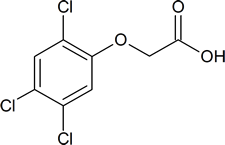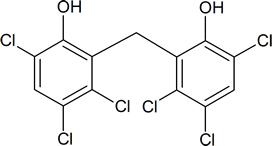


 علم الكيمياء
علم الكيمياء 
 الكيمياء التحليلية
الكيمياء التحليلية 
 الكيمياء الحياتية
الكيمياء الحياتية 
 الكيمياء العضوية
الكيمياء العضوية 
 الكيمياء الفيزيائية
الكيمياء الفيزيائية
 الكيمياء اللاعضوية
الكيمياء اللاعضوية 
 مواضيع اخرى في الكيمياء
مواضيع اخرى في الكيمياء
 الكيمياء الصناعية
الكيمياء الصناعية |
Read More
Date: 15-5-2017
Date: 6-10-2020
Date: 18-9-2019
|
One substance that has become symbolic of the struggle between industrial development and environmental protection is dioxin. The name dioxin is used to refer to a family of compounds having a basic structure in which two benzene rings are joined by two oxygen atoms:

However, media references to dioxin are usually in connection with 2,3,7,8‑tetrachlorodibenzo‑ p‑dioxin, or TCDD:

TCDD is a by‑product formed in the manufacture of trichlorophenol, an intermediate in the production of the herbicide 2,4,5‑T (one of the ingredients of the infamous Agent Orange), in the manufacture of hexachlorophene, by pulp and paper mills that use chlorine to produce white paper, and as a result of the incineration of municipal refuse.


The equation given below shows how 2,3,7,8‑tetrachlorodibenzo‑ p‑dioxin is formed during the manufacture of 2,4,5‑trichlorophenol, an intermediate produced in the synthesis of 2,4,5‑T. The process involves the reaction of 1,2,4,5‑tetrachlorobenzene with base at a temperature of about 160°C.


The possible hazards presented by dioxin first became apparent in 1957, when some German workers involved in the manufacture of 2,4,5‑T developed chloracne—a skin condition resembling acne. The precise toxicological effects of dioxin on humans is open to debate, but as little as 0.6 mg per kg of body weight will kill 50% of guinea pigs injected with TCDD within a specified time.



|
|
|
|
للعاملين في الليل.. حيلة صحية تجنبكم خطر هذا النوع من العمل
|
|
|
|
|
|
|
"ناسا" تحتفي برائد الفضاء السوفياتي يوري غاغارين
|
|
|
|
|
|
|
نحو شراكة وطنية متكاملة.. الأمين العام للعتبة الحسينية يبحث مع وكيل وزارة الخارجية آفاق التعاون المؤسسي
|
|
|